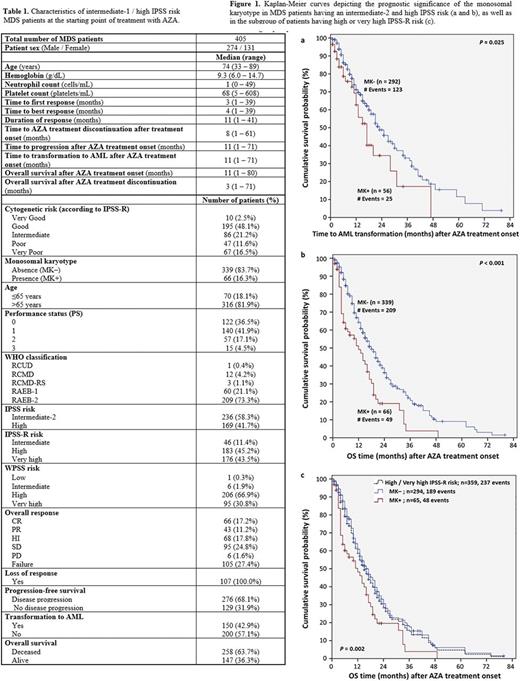Abstract
INTRODUCTION: Cytogenetic abnormalities constitute an important prognostic factor in myelodysplastic syndromes (MDS). Recently, a new cytogenetic group termed monosomal karyotype (MK), defined by the presence ≥ 2 autosomal monosomies or one autosomal monosomy plus at least one structural abnormality in the same clone, has been introduced and was associated with worse outcome in patients with acute myeloid leukemia (AML). 5-Azacitidine (AZA) is a front-line treatment for high-risk patients (intermediate-2 or high IPSS risk) with MDS and AML who are ineligible for intensive chemotherapy. The prognostic impact of MK+ in AZA-treated patients remains unclear. In this study, we investigated the incidence and prognostic impact of MK in MDS patients treated with AZA.
METHODS: This retrospective study of the Hellenic MDS Study Group included 405 intermediate-2 or high risk MDS patients treated with AZA. Extensive biostatistical analysis performed in this study included Kaplan-Meier survival analysis and Cox regression. The level of statistical significance was set at a probability value of less than 0.050 (P <0.050).
RESULTS: The median age of patients was 74 years (range: 33 - 89). Baseline patient characteristics are presented in Table 1. MK was identified in 66 out of 405 (16.3%) patients, most of whom had complex karyotype. The overall response rate in the entire cohort was 46.2% (CR: 17.2%, PR: 11.2%, and HI: 17.8%). Stable disease (SD) was achieved by 24.8% of patients, while 29.0% had progression of disease (PD) or treatment failure. ORR was not different between MK+ and MK- patients (46.6% vs 46.2%). During a follow-up time period of 18.0 months, the duration of response was 1 - 41 months (median: 11) in the entire cohort, 9.5 months (range: 3 - 28) in MK+ patients and 11 months (range: 1 - 41) in MK- patients. The estimated median time to transformation to AML for MK+ patients was 17 months (95% confidence interval [CI] = 12.4-21.6) vs. 23 months (95% CI = 18.8-27.2) for MK- patients (P=0.025) (Figure 1a). Multivariate Cox regression analysis revealed that performance status (hazard ration [HR]=2.0, 95% CI = 1.5-2.8, P <0.001), IPSS-R (HR=1.5, 95% CI = 1.2 - 1.9, P <0.001) and MK (HR=1.8, 95% CI = 1.2-2.7, P=0.002) were independently associated with overall survival (OS). The estimated median OS for MK+ patients was 12 months [95% CI = 7.8-16.2] vs. 18 months; [95% CI = 15.3-20.7] for MK- patients (P <0.001) (Figure 1b). In a subgroup consisting of high and very-high risk patients according to IPSS-R, MK- patients showed better OS rates that MK+ patients (estimated median OS: 17 months; 95% CI = 14.1-19.9 vs. 12 months, 95% CI = 6.6 - 17.4, P=0.002) (Figure 1c).
CONCLUSIONS: MK is associated with reduced OS in patients with intermediate-2 or high risk MDS treated with AZA. In MDS with high or very high IPSS-R risk score, MK can further distinguish patients with poorer outcome.
No relevant conflicts of interest to declare.
Author notes
Asterisk with author names denotes non-ASH members.


This feature is available to Subscribers Only
Sign In or Create an Account Close Modal